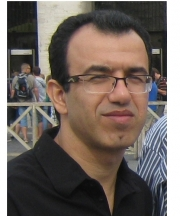Application of Amino and Thiolated Multi-walled Carbon Nanotubes for Removal of Mercury from Aqueous Solutions
Author(s):
Abstract:
Mercury is a highly toxic and accumulative metal and its compounds, especially methyl mercury, are neurotoxins which cause blockage of the enzyme sites and interfere in protein synthesis. The fate of inorganic, mercury ions in nature is its turning into methyl mercury due to the aerobic action of microorganisms. Mercury is a toxic metal that causes the serious environmental problems. The main sources of mercury ions in aquatic ecosystems are divergent, chloralkali wastewater, oil refineries, power generation plants, paper and pulp manufacturing, rubber processing and fertilizers industries. Various methods have been used for removing heavy metals from aqueous environment such as reverse osmosis, chemical precipitation, ion exchange, coagulation and adsorption. Many carbon-based nanoparticles (CNTs) have been developed to remove heavy metals from aqueous media. They are promising material for numerous applications due to their unique electrical, mechanical, thermal, optical and chemical properties. In addition, CNTs are proven to be superior adsorbents for several divalent metal ions in water, because of their capability to establish (π–π) electrostatic interactions as well as for their large surface areas. Therefore, they have received considerable attention for usage in analytical chemistry and environmental remediation. Multi-walled carbon nanotubes (MWCNTs) were the first observed CNTs involving of up to several tens of graphite shells. The sorption capability of MWCNTs is related mainly to the functional groups attached on its surface. Generations of functional groups on the surface carbon nanotubes improves the reactivity and provides active sites for further chemical modifications. Many researchers have developed amino and thiol functionalization on carbon-based adsorbents and CNTs in order to increase the adsorption capacity, selectivity and removal efficiency of heavy metals and organic compounds. Among these functional groups, the thiols have an excellent binding ability to some metals such as silver, mercury, copper, nickel and zinc. In present study, multi-walled carbon nanotubes were functionalized in four stages to create thiolated multi-walled carbon nanotubes (MWCNTs-SH). The synthesized amino and thiolated MWCNTs were characterized by Fourier transform infrared spectroscopy (FT-IR) and elemental analysis (CHNS) to ensur successfully entailing the functional groups on MWCNTs surface. The efficiency of all synthesized MWCNTs in mercury removal was investigated. MWCNTs-SH was more efficient rather than other synthetized adsorbents in mercury removal from aqueous solutions. Increasing in adsorbent dosage concluded an enhanced mercury removal. Solution pH has a more effect on mercury removal. When the pH increased from 2 to 8 the removal percentage ranged from 9.8 to 92%. The data fitted by Langmuir isotherm model (R2=0.966) better than Freundlich model (R2=0.935). The obtained maximum adsorption capacity (qm) by Langmuir model was 206.64 mg/g while its experimental value was 160.90 mg/g and was higher than that reported in other literatures. Thus the prepared synthetized adsorbent has high efficiency for mercury removal from aqueous solutions.
Keywords:
Language:
Persian
Published:
Quranic Knowledge Research, Volume:15 Issue: 4, 2016
Pages:
97 to 104
magiran.com/p1489632
دانلود و مطالعه متن این مقاله با یکی از روشهای زیر امکان پذیر است:
اشتراک شخصی
با عضویت و پرداخت آنلاین حق اشتراک یکساله به مبلغ 1,390,000ريال میتوانید 70 عنوان مطلب دانلود کنید!
اشتراک سازمانی
به کتابخانه دانشگاه یا محل کار خود پیشنهاد کنید تا اشتراک سازمانی این پایگاه را برای دسترسی نامحدود همه کاربران به متن مطالب تهیه نمایند!
توجه!
- حق عضویت دریافتی صرف حمایت از نشریات عضو و نگهداری، تکمیل و توسعه مگیران میشود.
- پرداخت حق اشتراک و دانلود مقالات اجازه بازنشر آن در سایر رسانههای چاپی و دیجیتال را به کاربر نمیدهد.
In order to view content subscription is required
Personal subscription
Subscribe magiran.com for 70 € euros via PayPal and download 70 articles during a year.
Organization subscription
Please contact us to subscribe your university or library for unlimited access!


